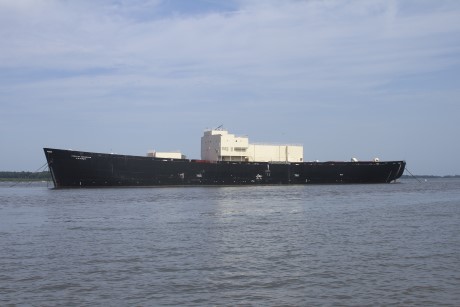An unsung hero makes its last voyage
24 April 2015
The last days of the Sturgis may herald a new dawn for floating nuclear plants, writes Will Davis.
When on the morning of 16 April, a set of tugboats surrounded and slowly moved off from the James River Reserve Fleet a long-silent, if well-kept vessel, there were no ceremonies, no fanfare, no water cannon salutes. There were a couple of informal photographs taken, but the final chapter in the life of the world's first floating nuclear power plant began almost without notice on that bright, clear day.
Officially known as MH-1A, the vessel was named Sturgis, after General Samuel D Sturgis, Jr.
Sturgis has gone largely unknown in marine circles and in nuclear energy circles, primarily because of the military nature of the entire project. While there were public materials circulated in the 1950s showing a US Army conceptual nuclear power barge that could be towed almost anywhere to provide power to shore, there was precious little published for public consumption when the project was brought from concept to actual hardware.
Sturgis was constructed by cutting in half the former SS Charles Cugle and inserting a new midsection that contained a nuclear power plant designed by Martin-Marietta. The reactor was a single loop pressurized water type rated at 45 MWt; the turbine-generator on board provided 10 MWe to a portable electric substation which the ship would take with it. The ship could not propel itself, and as such was properly a barge - although it did retain a rudder to help steer itself as it was moved along by tugboats. The US Army would own and operate the vessel, in line with the US concept that it would operate all small, low output, rapidly deployable nuclear plants whether for land or coastal use.
 |
| Sturgis at anchor in the James River Reserve (Image: Bloodgood US ACE) |
The reactor was first started up on 25 January 1967; the plant generated its first electric power in August of that year. All of 1967 and the first half of 1968 was taken up with shakedown and testing operations, crew training, and some modifications (including rebuilding of the turbine.) History was made on 5 October 1968 when Sturgis became the first floating nuclear power plant to provide power to an onshore grid; the location was Gatun Lake, Panama Canal Zone, where Sturgis would remain (with the exception of a drydock visit in 1972) for its operational life through 1976.
The novel power plant performed its duties without major interruption (although with the small problems any sort of machine might have) and refuelled several times through the time in 1976 when it had been rendered redundant; Sturgis was moved back to the USA and had the reactor's fuel removed at Fort Belvoir, Virginia (more or less the US Army's centre for nuclear energy, at least in the Eastern US) in the summer of 1977. The power plant would never operate again, and for most of the next 30-plus years the ship would ride at anchor in the James River Reserve fleet – a mothballed, 'ghost' fleet of ships that might someday be needed for purpose or purposes unknown.
Of course, history shows that the US Army's nuclear power program did not progress like that of the Navy, and eventually in more modern times the Army (now, actually, the Army Corps of Engineers) found itself with several nuclear plant possession licenses it would prefer to dispose of - none of which had operated for many years, it should be understood. Sturgis was among these, and again, as with the whole of the Sturgis' life, very quietly contracts were prepared to decommission and dismantle the ship. It was announced a while back that US firm Chicago Bridge & Iron would dismantle the nuclear plant and take care of disposal of all related materials at Galveston, Texas; once that was complete, the contract shows, the rest of the ship will probably be scrapped at Brownsville, Texas. Although there has been some contention between local town councils and the Army Corps of Engineers, it would appear that the job will go through.
And so we come to April this year, 48 years after the construction of the first floating nuclear power station (itself now at sea in transit) and we find a contrast. On the one hand, Russia is giving much fanfare to the Akademik Lomosonov, a two-reactor floating nuclear plant often described as "the world's first", which is slated to start operations within two years. As a result of this development various towns and organizations have begun to probe the idea that such floating power stations could enliven many Arctic shore-side areas, and in some quarters a feeling of futuristic hope has been kindled should more of these be built and deployed. On the other hand, quite apart from the fanfare, the real first of her kind, Sturgis, has moved off to the Gulf where she will meet her end.
And what of that end? Well, some materials have been preserved, including the ship's wheel and many documents, and there may yet be attempts to preserve more as the ship is disassembled - but that is a stretch. The technical details of the ship's construction and operation, though, are relatively insignificant when compared with the early date of construction and operation of Sturgis, which even today in places is being hailed as the most modern of developments. Those who know of Sturgis, understand that it is not - not by a long shot.
Will Davis
Comments? Please send them to editor@world-nuclear-news.org
Will Davis is the communications director of the NS Savannah Association, Inc, a consultant to the American Nuclear Society and a contributing reporter to Fuel Cycle Week.